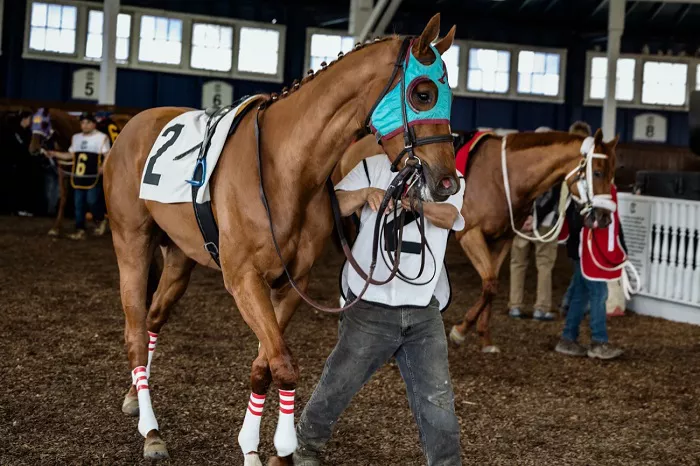The U.S. horse racing industry is facing a growing challenge as it struggles to secure enough workers to maintain operations, with many relying on foreign laborers employed under temporary H-2B visas. At the heart of the workforce are immigrants, including many from Mexico, who have long been integral to the industry’s success.
Diana Pinones, a staple at the Laurel Park racetrack in Maryland, is one such example. Her parents, originally from Michoacán, Mexico, have worked in the horse racing industry for decades—her mother now retired, and her father still grooming horses. Pinones herself has spent the past decade working with the Maryland Thoroughbred Horsemen’s Association, forging relationships with immigrant workers who make up a significant portion of the track’s workforce. “We rely 100% on immigrants, from the hot walker to the groom to the jockey,” Pinones explained, emphasizing that virtually everyone in the industry comes from abroad.
The horse racing sector generated approximately $36 billion in 2023, according to the American Horse Council, with many tracks relying heavily on H-2B visa holders to fill crucial roles. The H-2B program allows employers to hire foreign workers for seasonal, non-agricultural jobs, but many trainers and owners say it’s increasingly difficult to find U.S.-born workers to meet their needs. While jockeys can qualify for special visas, the rest of the workforce, including grooms and hot walkers, typically rely on H-2B visas. However, a significant portion of the labor force remains in the U.S. without legal status, according to industry groups.
This year, two key worker visa programs—the H-1B and H-2B—have reached their annual caps, creating further uncertainty. The H-1B visa, for workers with higher education degrees, and the H-2B visa, for non-agricultural seasonal labor, are both essential to industries like horse racing. The U.S. Citizenship and Immigration Services (USCIS) announced in March that neither visa would be available for the 2025 season.
States like New York, where horse racing is a major industry, are among the largest recipients of H-2B visas. Although the workers granted visas for 2025 will not begin work until the fall, employers like Pinones are already looking ahead to the future, concerned about staffing challenges next season.
Increased Demand Amid Immigration Crackdown
Labor experts warn that the rising demand for visas underscores a critical reliance on immigrant labor, with the industry fearing that political pressures could lead to stricter immigration enforcement. Under the Trump administration, there were efforts to reduce both legal and illegal immigration, and some worry that ongoing changes could negatively impact their ability to maintain a stable workforce.
James O’Neill, director of legislative affairs at the American Business Immigration Coalition, called the H-2B and H-1B visa programs a “last resort” for employers. “It’s more expensive to use those visa programs than it is to hire domestically,” O’Neill said, noting that employers must demonstrate a genuine inability to find domestic workers before being granted visas. The caps on these programs have been hit every year for the past several years, highlighting the growing demand for foreign labor, O’Neill added.
Lynden Melmed, a former chief counsel for USCIS under President George W. Bush, pointed out that while the political climate is uncertain, employers are looking to secure their workforce by relying on visa categories that may be impacted by policy shifts. “We need to secure a consistent workforce because we’re not really sure how these immigration enforcement trends are going to affect current and future employees,” Melmed said.
Workers from Mexico make up a significant portion of the H-2B labor force, followed by other countries like Jamaica, Guatemala, and Honduras. The annual cap for H-2B visas is set at 66,000 for 2025, and there are concerns that future caps could be reduced or the programs frozen entirely, as happened with the H-1B visa program during Trump’s first term.
Industry Faces Staffing Struggles
Back at Laurel Park, Pinones and others work tirelessly to support the immigrant labor force that sustains the industry. Trainers like Ferris Allen, who has been in the business for 27 years, rely on about 14 employees to care for his horses. While the process of securing visas and green cards is costly and complex, Allen emphasizes its importance in maintaining a skilled workforce.
“We have a couple of Mexican families that we work with, multiple family members,” Allen said. “Those workers are essential to our business.” He added that while finding domestic workers who are as dedicated and skilled is rare, immigrant laborers take pride in their work, particularly when it comes to handling the often unpredictable and dangerous nature of racehorses.
Although there is some stability for now, industry insiders remain concerned about the future of H-2B visas. Pinones, who has helped countless workers navigate the complexities of immigration paperwork and even apply for green cards, remains committed to ensuring that her colleagues succeed. “Generation after generation, they have been doing this job,” she said. “But without the visas, we cannot continue to do this.”
Related topics:
- AI Tools Drive Trump-Era Immigration Crackdown, Raising Alarms Over Accuracy and Civil Liberties
- Vatican Calls for Dialogue Amid US Immigration Debate During Vice President Vance’s Visit
- Quebec Calls for Federal Immigration Cuts, Sparking Concern Among Businesses


